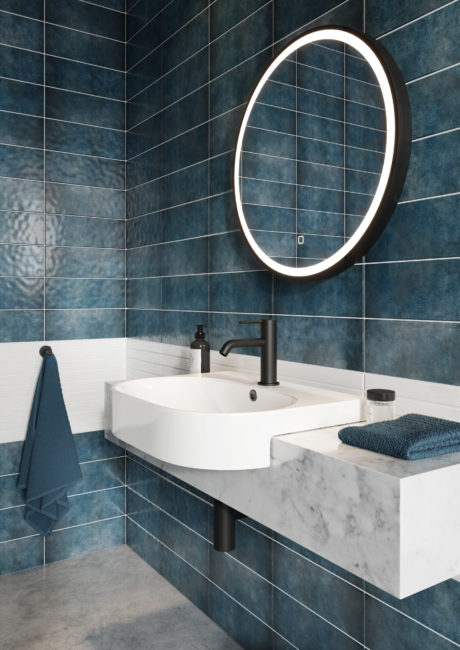Tiling in the bathroom has never been more popular – 75% of the bathrooms we sell have fully tiled floors and full or partially tiled walls. Although a large percentage of these tiles are light coloured for example White, Ivory or Beige there is a growing tendency towards earthy colours for example greys and browns.
Whichever colour you choose for your bathroom please bear in mind a few key points.

Tilers
Firstly choose your tiler well – excellent quality tiling takes real skill – don’t be afraid to ask for references from your chosen installer before you accept their quote. The cheapest quote is not usually the best. Generally the more time the fitter takes on tiling (within reason) the better the result – more time usually means more days labour and more cost for the installation.
Preparation
Secondly, good preparation is essential i.e. getting the walls and floors level and solid before beginning will make all the difference in ensuring the finished tiled surface is nice and level. If you begin with uneven surfaces no amount of adhesive will compensate perfectly and you will find undulations with tile junctions slightly out of alignment possible even slightly sunken or raised. similarly if you don’t ensure a solid surface under the tiles movement over time will cause grout, adhesive and even tiles to crack.
Adhesives
Thirdly, use good quality adhesives and grouts that suit the application. This goes without saying for example first floor or above it is usually wise to use a flexible two part adhesive and grout to prevent movement cracking.
Materials
Fourth – choose tiles wisely. Think about colour coordination with walls floors, borders, recesses and don’t forget grout colours – these can be blended in with the tile colours or used to highlight tiles with more stand out colours. Think about how dirt will show up on the floor and how non-slip the floor tiles will be when wet (there is always a compromise between non-slip and ease of cleaning).
Generally use porcelain on floors as it is harder than normal ceramic (sometimes thicker ceramics are still suitable for floors – ask the manufacturer). In general larger format tiles make a room look bigger but there is a compromise as some of the really large tiles around a meter or more can be very hard for the installer to handle and cut
Patterns
And finally, discuss the tiling pattern with your installer to make sure that borders are at the right height and that tile centres will line up with the appropriate fixtures and fittings. Patterns are generally quite nice to use but don’t over do it – if you use a more complicated pattern on the floor or the wall then use a simpler pattern on the alternate surface. When creating tiled shower bases, mosaics can avoid the many cuts otherwise required in large format tiles.
Ultimately tiling a bathroom well makes it look bigger, cleaner, more beautiful and adds value to the room!
